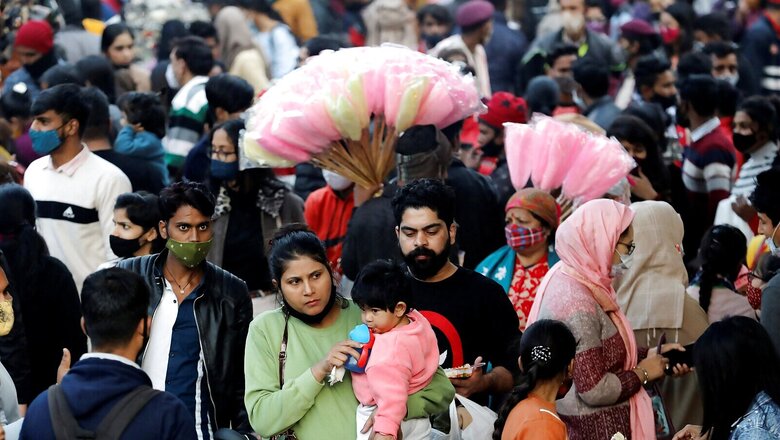
views
Budget 2022-23 carries forward the NDA government’s growth and development efforts into the next year. The current year has been outstanding for the Indian economy; the GDP has increased from Rs 197 lakh crore to Rs 232 lakh crore, a rise of Rs 35 lakh crore—at Rs 75-to-a-dollar, that is an increase of $466 billion in a year. This is enormous and we can see India’s GDP growing to nearly $3.15 trillion, a nominal growth of around 17.5 per cent.
This high growth, coming on the back of a COVID-hit year, is a testimony to the robustness of the Indian economy and the many initiatives taken by the government to protect India in the wake of a shutdown.
Budget on Earnings and Expenditure
The government budgeted gross tax revenue at Rs 22.17 lakh crore, in the revised estimate, it increased the revenue to Rs 25.16 lakh crore, a jump of Rs 3 lakh crore. However, when one looks at the government data, the tax collection figures till December 2021 stood at Rs 19.28 lakh crore, and then considering the tax collection between January-March to be comparable to last year, at about Rs 6.85 lakh crore, the total tax collection could be Rs 26.13 lakh crore. It is clear that the government has underestimated tax collection in its revised estimate.
There are other elements of surprise too. The disinvestment target of Rs 1.75 lakh crore, for instance, has been reduced to Rs 78,000 crore in the revised estimate, which means LIC disinvestment target of Rs 1 lakh crore could be reduced to Rs 50,000 crore. The next year’s disinvestment target has been brought down to Rs 65,000 crore. For the first time in the last two-three years, we do not have a high disinvestment target in the Budget.
In terms of dividend received, we have seen an increase from Rs 1.03 lakh crore to Rs 1.47 lakh crore because of the increase in the dividend paid by the RBI, which was 43,000 crore. For the next year, the target has been brought down to Rs 1.13 lakh crore. Overall, if one looks at the revised budgetary estimates, it shows a very healthy trend.
Looking at next year’s gross tax revenues, the government has budgeted Rs 27.57 lakh crore in FY2023, a nearly 10 per cent increase from Rs 25.16 lakh crore in FY22. But this again is an underestimation because the tax collection this year can go up by Rs 1 lakh crore-Rs 1.5 lakh crore based on growth in direct taxes, and next year, we could reach Rs 30 lakh crore in tax collections. Government could have estimated the targets slightly better so that it could have taken some steps to give relief to the middle class.
Next year’s expenditure is estimated at Rs 39.45 lakh crore, which is a good estimate because in the current year’s Budget, around Rs 1.5 lakh crore will be spent on one-off expenses—Rs 67,000 crore for Air India to pay off its liabilities, Rs 53,000 crore for paying off the subsidies due on the exports for the previous year, and about Rs 50,000 crore on food subsidies (which is not applicable next year).
This year is going to be financed by market borrowing of only Rs 10.40 lakh crore in terms of government securities as against the budgeted Rs 12.05 lakh crore. Next year, we will see a massive increase in borrowing, up to Rs 14.95 lakh crore. The larger part of the borrowing is coming from small savings; this year it is around Rs 6.5 lakh crore, next year it will be less than Rs 5 lakh crore. Obviously, in the entire Budget, the government has made sure that odds are in its favour for revenues to increase, and to ensure it has the ability to meet sudden demands on expenditure.
This year, the economy is expected to grow by 9.2 per cent and next year by 8-8.5 per cent, and in nominal terms, it may be around 12 per cent. A redeeming factor of this year’s Budget has been the increase in spending on infrastructure, going up to Rs 7.50 lakh crore, which is roughly 3 per cent of the GDP. Along with other public sector infrastructure investments, the spending is projected to go up to Rs 10.68 lakh crore in 2022-23. As part of this, the government is also giving Rs 1 lakh crore to the states as 50-year interest-free loan to boost capital expenditure by states, as against Rs 15,000 crore this year.
Push to Green Sector and Make in India
The Budget has also announced several reform initiatives. Aspirational district programme, repeal of 25,000 compliances, emphasising on a trust-based governance, e-passports, focus on urban planning and public transport, use of technology for land records, improving the insolvency process etc., are all welcome steps.
Another big feature is that 68 per cent of all defence purchases next year will be domestic as against 58 per cent this year. The Make in India programme is being given a boost and the government means business.
In line with PM’s vision at COP26 of India generating 50 per cent of its total energy requirement through alternative energy modes, Rs 19,500 crore will be given as PLI (production-linked incentive) for solar modules. Besides, there is a massive thrust on electric vehicles and solar and wind energy.
Venture Capital Industry, Startups Left High and Dry
But, as far as the venture capital industry is concerned, there is hardly anything in the Budget, even though this industry has been an engine of growth with $40-billion investment and 43 unicorns in 2021. An expert committee is being set up to review the matters raised by the industry to ensure ease of compliance.
For startups, it has been a disappointing Budget. The government has reduced surcharge on all non-listed assets to 15 per cent from 37 per cent, which is also applicable to investment in startups. But, an Indian investor continues to pay 20 per cent tax on capital gains in unlisted companies, including in startups, as against a foreign investor who pays 10 per cent tax.
The government also announced that for startups, the tax break in three out of 10 years will continue for one more year. This is a classic case of a government scheme, supposedly designed to give tax benefit to startups, listing such difficult conditions that almost none can make use of it.
Of the 60,000 startups in India, only 600 are reportedly approved for this scheme. Better do away with the charade of giving startups a tax break.
The discrimination in the Indian tax policy against an Indian who wants to stay in this country, wants to invest and grow in India continues even with the NDA government. Over the last seven years, 10,000 multi-millionaires have reportedly left this country because of tax terrorism, high taxes etc., and along with them, Rs 20,000-Rs 30,000 crore worth of annual consumption has also gone. It looks as if it is much better for a high net worth individual to leave this country, become an NRI and earn more and pay lesser taxes, have a better quality of life than to live here and grow.
Nothing for Middle Class
It is also disappointing that the middle class has been totally ignored. This section of society has suffered greatly during the COVID-19 pandemic, having lost jobs, having to pay more for medical expenditure and, generally, having to stay indoors during the lockdown and see their income and savings dwindle.
This middle class is the driver of consumption in the Indian economy. Of the 138 crore people in India, about 100 crore live on less than $1000 a year. The remaining Indians live on $5000 a year—they are the ones who buy cars, take home loans. You can easily do the math: an estimated 8 crore people file Income Tax returns every year, and if you take a family of four, that is 32 crore—which constitutes India’s middle class.
They are the main taxpayers in this country and major consumers too, and they have suffered a lot in the last two years. They had expected the government to give them some tax relief. Last year, the government came out with a badly designed tax regime with a seven-slab tax payment.
We had hoped the government will reduce taxes for the middle class, especially given the massive increase in individual tax collection and growth in the economy. This would have enabled people to have more cash in hand for consumption, particularly those above 55 and pensioners, who do not take advantage of housing tax deduction or other deductions. Rather than saving money (through tax saver instruments), this section needs more cash in their hand because they are starting to live off their accumulated savings.
The middle class was thoroughly ignored by the government even during the pandemic when relief was given to the poorer classes and not to the middle classes, who also suffered greatly. The government missed a great opportunity to deliver a truly transformative Budget, where tax relief could have been given to the middle class.
Overall, this government has continued its strategy of growth: giving states more money, and spending on infrastructure. India can expect to be on high growth path for the next two-three years. By 2026, there is a 90 per cent possibility of India reaching $5-trillion GDP target and there is an 80 per cent probability of reaching $10 trillion by 2032, if the rupee-dollar rates remain stable.
T.V. Mohandas Pai is Chairman, Aarin Capital Partners. The views expressed in this article are those of the author and do not represent the stand of this publication.
Read all the Latest Opinions here















Comments
0 comment